Public Pier — No Fishing License Required
In 1542 Rodriguez Cabrillo, the Portuguese navigator sailed northward from Mexico to explore the coast of California. After visiting the bay of San Luis Obispo (that he called the Bay of Todos Santos, or All-Saints Bay) he visited Morro Bay (Los Esters) and the huge rock (El Moro). Northward he sailed and soon entered a small bay which he named the “Bay of Sardines” — today’s San Simeon Bay.
Nestled in this small bay, protected by San Simeon Point, and somewhat out of sight of the cars passing nearby on Highway 1, sits the William R. Hearst Memorial State Beach and the popular San Simeon Pier. The beach park is a popular spot to stop and relax and contains picnic tables, barbecue pits, a eucalyptus forest, a small beach, and restrooms.
Across the highway sits the Hearst Castle State Park, one of the most visited parks in California, and up on the hill sits Hearst Castle itself, a beautiful place that everyone should visit at least once (or even more often since four separate tours are available).
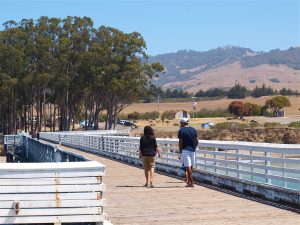
The entrance to Hearst Castle sits directly across HY1 and the castle sits high up on the hill
Environment. The pier itself is small, being 850-foot-long (some sources say 797) but only 12 feet wide. The deck sits 22 feet above the fairly shallow water and the bottom here is mainly sand although there are quite a few rocks south of the pier. There is often a heavy growth of kelp around the pilings during summer and fall months and pilings generally have a heavy growth of fish-attracting mussels.
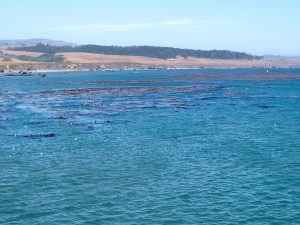
Looking south
To the north of the pier sits San Simeon Point; it forms and helps protect the cove. The point deflects many of the waves and one result is a generally mild surf on the beach adjacent to the pier. But not always! The pier, which was built in 1957, was repaired in 1969, 1982 and 1983, all as a result of damage from winter waves.
Due to the generally mild surf conditions the beach adjacent to the pier is very popular with families. Midway across the beach is a small creek that flows into the ocean. The creek attracts young and old bathers in the summer and a few steelhead in the fall.
The past few years has also seen the beach used to launch kayaks and kayak rentals and tours are available. Unfortunately all too often the kayakers do not use common sense and they decide to paddle through the pier’s pilings amidst the fishing lines of anglers on the pier. Sometimes a few choice words are the result.
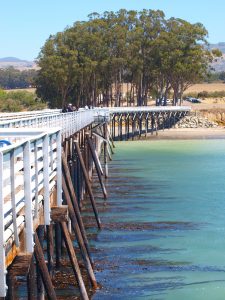
To the south of the pier are state beaches and generally narrow beaches; offshore sit kelp beds.
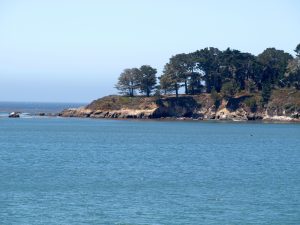
Looking north at San Simeon Point
Fish. The pier sits in a beautiful setting and has the look of an excellent fishing pier. Action, however, can vary. According to studies done in the ’60s by the California Fish & Game Department, the pier had one of the lowest catch-per-trip averages of any pier in this region. This was due primarily to lower than normal catches of several of the schooling species; in particular, the small surfperch, jacksmelt and bocaccio. The census did show that San Simeon had several resident species and also showed that San Simeon does see the schooling species. Rare however were the vast concentrations of fish that periodically showed up at Cayucos, Avila and Pismo Beach.
But, these old statistics should be viewed with caution. My personal records reflect a somewhat different story than the department’s statistics. Although my first few trips to the pier were only fair, trips during the ’80s and ’90s tended to be above average. This has been especially true while fishing the surf area for the larger surfperch. Whereas I have seen a decrease in the number of barred surfperch and calico surfperch at Pismo Beach and Cayucos, I have seen an increase in my catch of these fish at this pier. Perhaps this is an anomaly, but perhaps it simply reflects the fact that this pier receives far less fishing pressure than Pismo Beach or Cayucos. Generally, less pressure on a population of fish means better fishing.
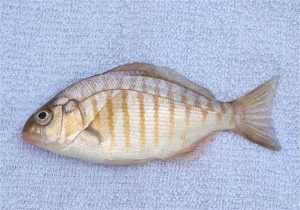
A barred surfperch from the pier
Additional insight comes from George Valenzuela, former owner of San Simeon Landing (1989-1994). George is a knowledgeable fisherman who grew up fishing on the Monstad Pier in Redondo Beach and a person who wrote a fishing column called “Fishing Tales” for several publications. One article he wrote concerned white croaker, a fish much maligned in southern California. In the article he described a couple that had caught several hundred white croaker from the end of the San Simeon Pier and how they planned to trade them for vegetables. He went on to suggest that locally caught white croaker were fine to eat and perhaps tastier than the white croaker in southern California (since local waters are often 15 to 20 degrees cooler). Although it is only one illustration, it shows that large concentrations of fish do visit the pier and that often large catches can be made from the pier. By the way, Valenzuela is also known as George “Tunabelly” Valenzuela and he owns and runs the website Senortuna.com.
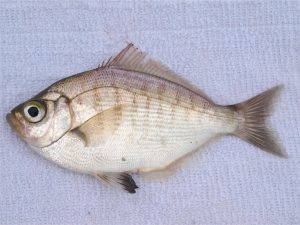
A walleye surfperch from the pier
Fishing Tips. Although a few species will be caught year-round (primarily barred surfperch, calico surfperch and white croaker), peak fishing normally occurs during the late spring to fall months when the residents are joined by immigrant species that move into the area for a few weeks, or even for several months. Inshore, fish just outside the surf area for barred surfperch and calico surfperch. Best bait for both is live sand crabs (sand fleas), but bloodworms, ghost shrimp, fresh mussel, and sometimes clams, are also excellent. But that isn’t always true. I got one interesting report in January of ’99 from the local Pier Fishing in California reporter, Greg Hickman. He reported that while calicos were falling to the usual mixture of sand crabs and mussels, the barred were hitting better on anchovies and cut mackerel — so go figure. During the past few years more and more anglers are also using the fish-skin multi-hook bait riggings. A final trick is to use plastic grubs, especially the root beer or motor oil colored lures. Attach the grubs directly to a hook on the end of your line with a small weight a couple of feet up from the lure and results can be deadly. Walleye and silver surfperch, as well as a few white seaperch, hit in this same area but also are caught out to the mid-pier area. They will hit the multi-hook rigs but are commonly caught on size 6-8 hooks baited with anchovy or squid.
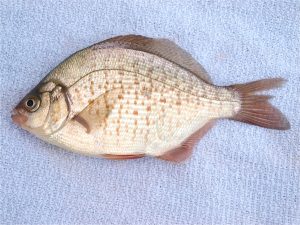
A calico surfperch from the pier
Quite often I’ve had good success on flatfish near the inshore cleaning station so I wasn’t too surprised when I got a report that in August of 1998 quite a few English sole (Parophrys vetulus) were being landed in this area, most of them 15-16 inches long. Together with the English sole were a few starry flounder, a fish that is known to breed with the English sole; their offspring is appropriately called the hybrid sole (Inopsetta ischyra). White croaker (tom cod) are typically caught year-round on almost any area of the pier but mid-pier to the end is optimum and small pieces of anchovy or squid will yield the most fish. Another fish caught year-round, typically out toward the end, is spiny dogfish (here called pinback sharks); most of these are landed by anglers using squid. Summer and fall are the prime time for the pelagics: Pacific mackerel, jack mackerel, jacksmelt, and perhaps even a stray bonito or barracuda during warm water years. The first three can be caught on multi-hook bait riggings but if the riggings don’t work, bait up a couple of size 4 or 6 hooks with small pieces of squid or salted anchovy; toss them out and reel in, slowly pausing at mid-depth when the line is near the pier. The fish will often follow the bait and hit just before you pull it out of the water. Best bet for a bonito would be an old-time bonito splasher; best bet for a barracuda would be a spoon. All of these pelagic species will be found in the deeper waters of the pier.
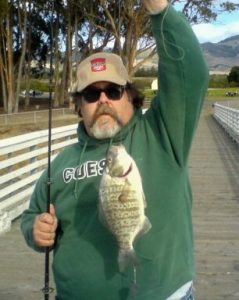
A barred surfperch caught by Gip.of.Paseo in 2008
Some years will see runs of the smallish-sized red snapper (juvenile bocaccio). Generally this is from spring to late summer but some years the run may last only a week or two, some years it lasts for a couple of months, and some years you don’t even see the fish. Most bocaccio are caught on artificial bait rigs fished near the bottom or at mid-depth range. Remember to not exceed the limit which is currently three fish — or basically one drop with a bait rig.
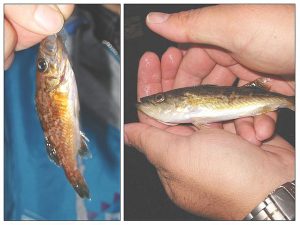 A baby bocaccio aka “red snapper”
A baby bocaccio aka “red snapper”
Flatfish are also common, primarily starry flounder in the winter, and sand soles and California halibut during the summer. Flounder and soles will hit on ghost shrimp, bloodworms or a piece of anchovy fished on the bottom; the halibut prefer live bait like a shiner, small smelt or walleye surfperch fished on a sliding leader. Still, some locals swear by frozen anchovies (using the rear half of the fish) and a 36-pound halibut was reported in 1998. Each year will also see a few halibut hitting the plastic twin tails being used by more and more anglers. If you catch a small flatfish, it may be a sole but more likely will be a small Pacific sanddab or a very small speckled sanddab; both like to inhabit the depression areas between the pilings. However, you never know what will show up as seen in April of ’99 when several Rex sole (Glyptocephalus zachirus) were caught from the area near the cleaning station. What the normally deep-water (60-2,100 feet deep) flatfish were doing in the shallow water is anyone’s guess. Similarly, several Pacific halibut have been reported from the pier, although none reached the gargantuan size of their far northern relatives.
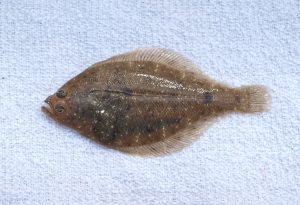
Small speckled sanddabs sometimes seem to cover the bottom
A final fish caught in fairly high numbers are the rock-dwelling striped seaperch that move into pier waters in the fall. These large perch like bloodworms (or fresh mussel) and the best spots are down around the mussel covered pilings, inshore to the middle of the pier. In the same area and caught with the same bait are large rubberlip seaperch and buttermouth perch (blackperch); they are most common from early spring to the start of the summer.
Fish caught in smaller numbers include a number of rockfish (sometimes called rock bass or sand bass) — kelp rockfish, grass rockfish and gopher rockfish. Into this mix will be added a few cabezon and lingcod. Shark species include the aforementioned dogfish together with brown smoothhounds, leopard sharks, and a few threshers. Occasionally even a blue shark will show up in the bay. Much more common are bat rays and big skates and both reach a pretty good size (one angler in August of 1998 fought a long fight with a bat ray estimated at 100 pounds but his nylon rope broke while bringing the fish up onto the pier). Some years will also see some good catches of thornback rays.
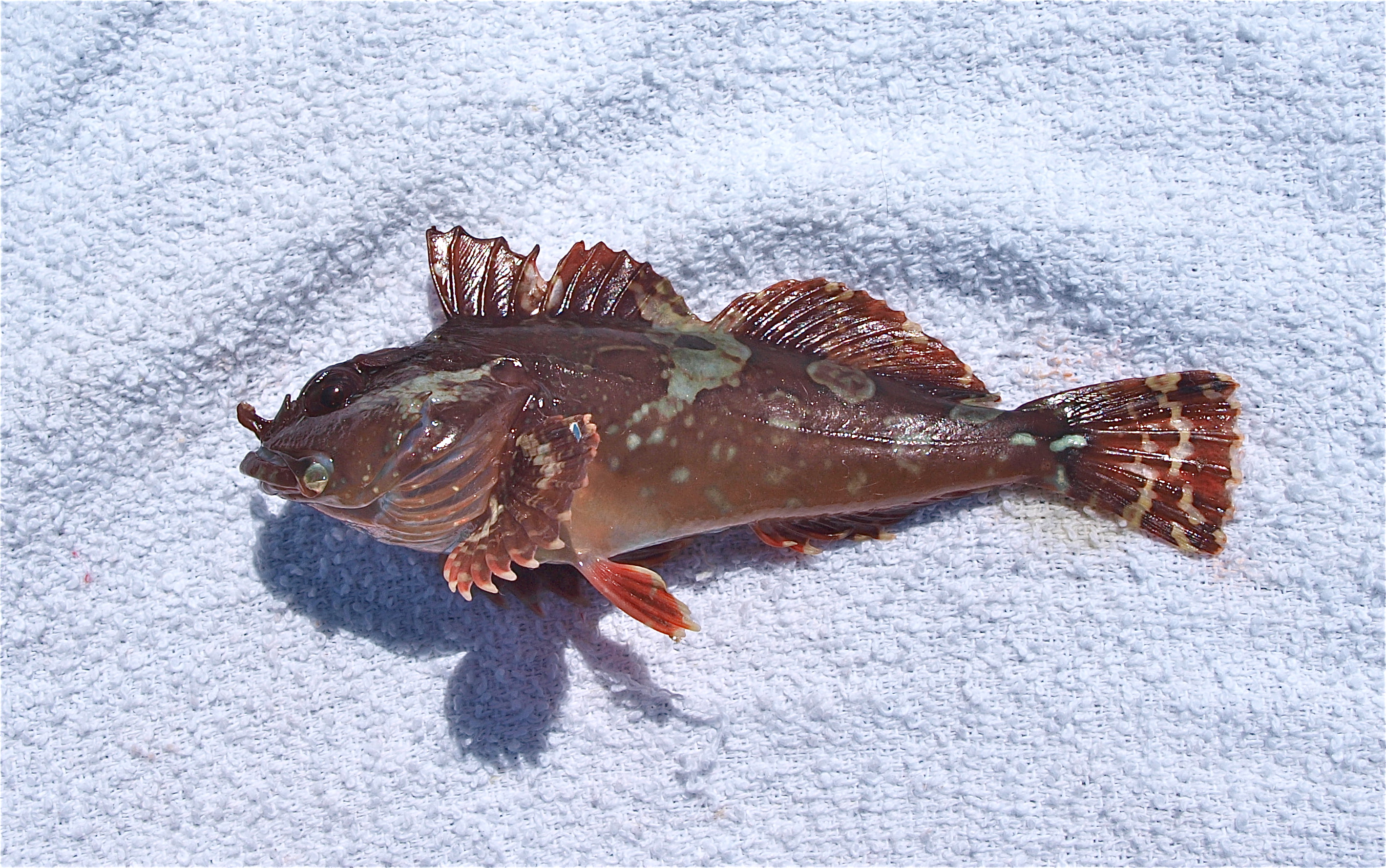
A small cabezon from the pier
Salmon can also be caught. In the past, most of the salmon were silvers (coho) and most were caught on jigs or other lures in the late summer or fall, although an 18-inch king salmon was landed in January of ’99. While most of the salmon seem to be in the 6-12 pound category, several larger kings (20+ pounds) have also been reported. Regulars watch for birds diving into the waters near the pier. The birds mean there is bait in the water and the salmon follow the schools of bait into the shallow waters. Fall to winter may also see a few steelhead landed, primarily on the north side by the creek. Worms and spoons such as Kastmasters or Krocodiles are generally the best lures for the steelhead. A 30-pound striped bass was landed by a surf fisherman fishing adjacent to the pier in 1998; an unusual catch for the area.
“The salmon that took the Southland by storm a few months ago have all but disappeared from local waters, but it appears they’re making a big splash up north where they belong. The most excitement recently was generated in the San Simeon area, where the fish chased bait into San Simeon Cove and stayed for three days, providing some of the best pier fishing ever for local anglers. “Everybody was catching them,” said Harry Neil, general manager of Virg’s Sportfishing whose boast are based at the pier. ” I went out there last Friday and the water was full of bait, and I saw these big silver flashes, so I grabbed my mooching rod and four anchovies, and with the four anchovies I caught three fish and kept two.” Neil said the bay bite ended Monday. “
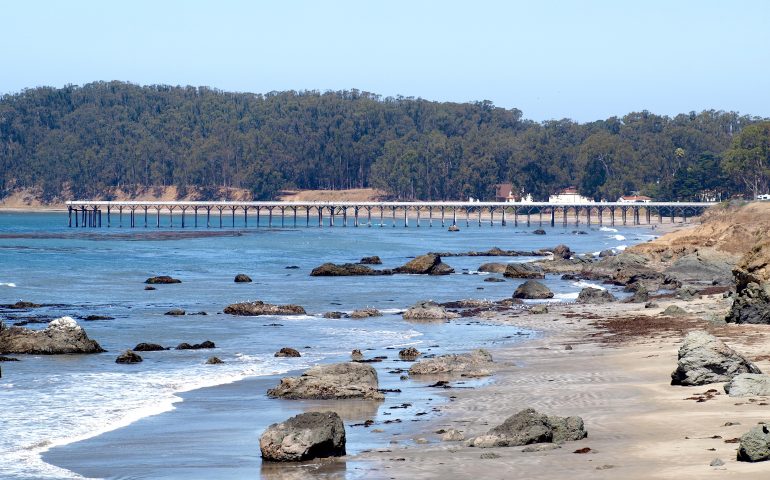
Hello to all, I am Coming down for a B-day Week and was interested in doing some free-diving and crabbing to the north of the pier. what is your experience with catching Dungeness Crab in the area? I have been trying to find some information due to never having fished central or southern California. Any insight or tips would be greatly appreciated. Thanks in advance.
Fished San Simeon today with my kids. Pretty good action on high/low rigs, #8 hooks, and bloodworms. Three 10″ or so white seaperch, mid-pier around pilings. Couple decent barred surfperch just outside surf. Too many people to fish the breakers much. Son caught a nice sized jacksmelt, and everyone had a few speckled sanddabs, they were everywhere.
Hit San Simeon pier again this weekend. Big surf and quite windy, but barred surfperch action was great on 2″ Gulp sandworms,
with #6 hooks on a high-low setup. Fished just behind and in the breakers. Pretty slow everywhere else further out on the pier.